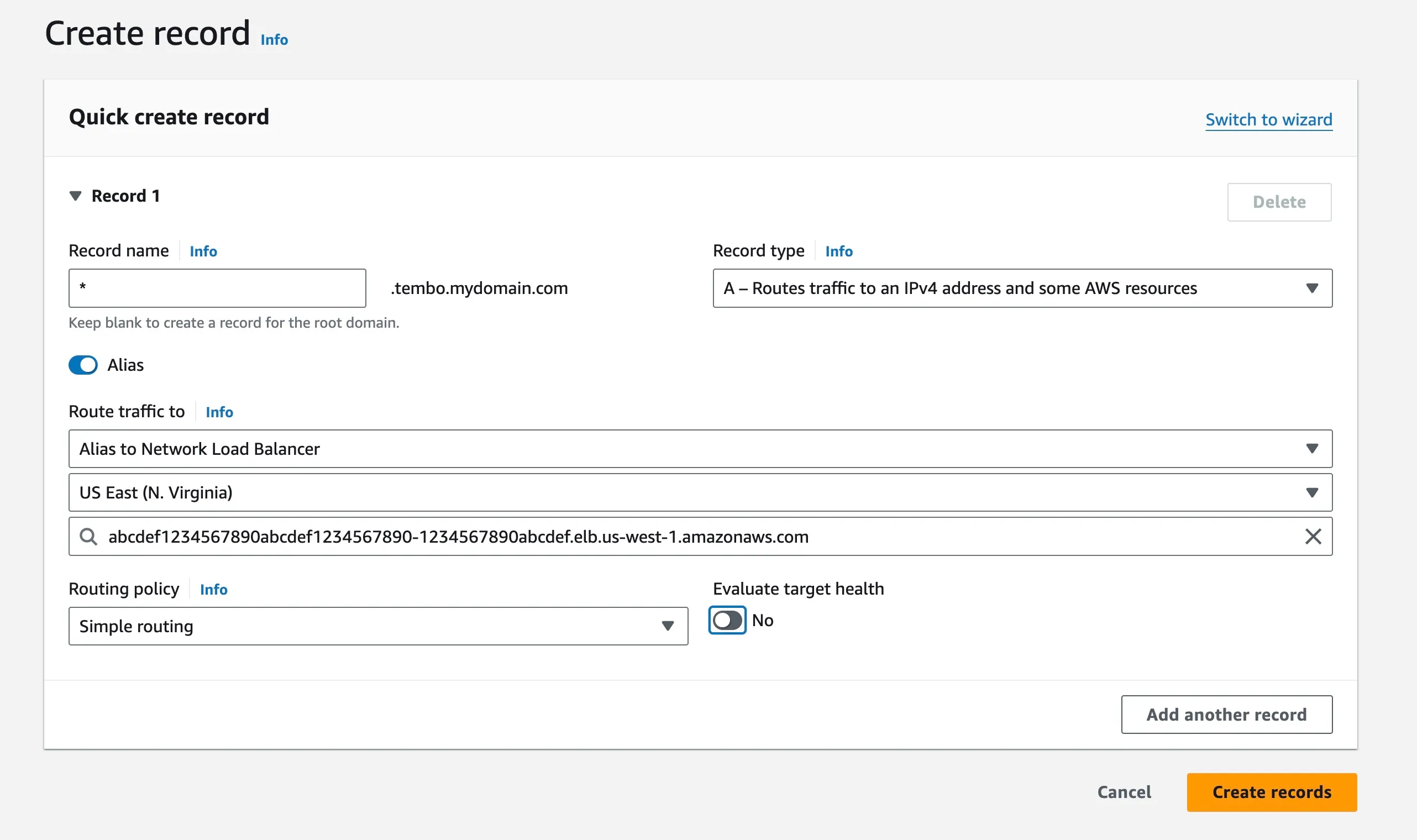This guide describes the steps to install Tembo Self Hosted on AWS, which allows you to deploy a high-performance, fully-extensible managed Postgres service within an AWS Elastic Kubernetes Service (EKS) cluster.
Step 1: Prerequisites
Before starting this tutorial, you must install and configure the following tools and resources that you need to create and manage Tembo Self Hosted on an Amazon EKS cluster.
- Amazon EKS Cluster
- Kubernetes (kubectl)
- Amazon EKS (eksctl), used to create and manage your Tembo cluster on EKS
- Helm CLI
- Obtain a Clerk authentication key from Tembo
Step 2: Prepare for Tembo installation
Prepare Tembo helm chart installation by running a script using the command below. It does following:
- Enables IAM OIDC Provider
- Creates the Amazon EBS CSI driver IAM role
- Adds the Amazon EBS CSI driver add-on
- Update the StorageClass to allow for volume expansion
- Give Cluster Node IAM role permission to ChangeResourceRecordSets & ListResourceRecordSets for Route53
bash <(curl -s https://raw.githubusercontent.com/tembo-io/tembo-self-hosted/main/scripts/aws/eks-setup.sh)Step 3: Install the Tembo Self Hosted Helm chart
Add Helm repo for Tembo & do an update
helm repo add tembo https://tembo-io.github.io/tembo
helm repo updateNow, create a file my-values.yaml with the following content:
global:
baseDomain: tembo.mydomain.com
tembo:
cpWebserver:
env:
- name: CLERK_SECRET_KEY
value: <secret-key>
- name: CLERK_WEBHOOK_SIGNING_SECRET
value: <signing-secret>
- name: STRIPE_SECRET_KEY
value: <secret-key>
- name: STRIPE_WEBHOOK_SIGNING_SECRET
value: <signing-secret>
- name: METRONOME_SECRET_KEY
value: <secret-key>The basedomain is used to access tembo ui, api, dataplane & instances provisioned so you must set that up first.
Now, let’s install the Tembo Self Hosted Helm chart in your EKS cluster:
helm install tembo tembo/tembo -f my-values.yaml -n tembo --create-namespaceCheck the status of installation:
❯ kubectl get po
NAME READY STATUS RESTARTS AGE
control-plane-1 1/1 Running 0 82m
control-plane-queue-1 1/1 Running 0 79m
tembo-cloudnative-pg-749dcfc655-756mm 1/1 Running 0 83m
tembo-conductor-fb7878d7-tvh94 1/1 Running 0 77m
tembo-conductor-watcher-7ff9547686-6sld8 1/1 Running 0 77m
tembo-controller-57899fffc4-d4j55 1/1 Running 0 82m
tembo-cp-reconciler-76bd8777b6-z2nq8 1/1 Running 0 81m
tembo-cp-service-75bccdddbd-b8xbk 1/1 Running 0 78m
tembo-cp-webserver-686fb69bb5-w5g6g 1/1 Running 0 78m
tembo-dataplane-webserver-7f9bd5cbf7-gkk2w 1/1 Running 0 83m
tembo-init-cp-db-lxl2t 0/1 Completed 0 83m
tembo-init-cp-queue-db-lljgr 0/1 Completed 0 83m
tembo-label-namespace-ggnml 0/1 Completed 0 83m
tembo-pod-init-74975dbcb8-d9jpk 1/1 Running 0 83m
tembo-tembo-ui-685ccc9996-n8tmv 1/1 Running 0 83mStep 4: Configure DNS for Traefik’s Load Balancer
Add a wildcard DNS A record through your DNS provider. This is essential since each PostgreSQL instance has its own subdomain for its connection string.
-
Create a Wildcard A Record: Set up a wildcard CNAME record (e.g.,
*.tembo.mydomain.com). This will cover all subdomains for your PostgreSQL instances. -
Use the External IP: Point the wildcard CNAME record to the external IP of your Traefik load balancer. This external IP can be found using the command below.
kubectl get svc -n traefik
NAME TYPE CLUSTER-IP EXTERNAL-IP PORT(S) AGE
traefik LoadBalancer 10.200.50.100 abcdef1234567890abcdef1234567890-1234567890abcdef.elb.us-west-1.amazonaws.com 1234:56789/TCP,80:12345/TCP,443:23456/TCP 45mIf you’re using Amazon Route 53, the configuration should look something like the image below. For more detailed information, refer to Creating Records Using the Amazon Route 53 Console.

- Verify DNS Settings: After creating the CNAME record, verify that the DNS settings are correctly propagating and resolving.
You can use nslookup to check if your DNS settings are working correctly:
nslookup test.tembo.mydomain.com
;; Got recursion not available from 2001:4860:4860::8888, trying next server
;; Got recursion not available from 2001:4860:4860::8844, trying next server
Server: 8.8.8.8
Address: 8.8.8.8#53
Non-authoritative answer:
Name: test.tembo.mydomain.com
Address: 203.0.113.10
Name: test.tembo.mydomain.com
Address: 203.0.113.20Step 5: Access the Tembo Self Hosted
Access the Tembo Self Hosted UI by visiting http://app.tembo.mydomain.com in your browser. Replace tembo.mydomain.com with your domain name.